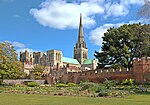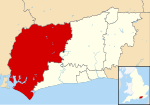The Novium

The Novium is a museum in Chichester, West Sussex, southern England. The name comes from the Roman name for the city, Noviomagus Reginorum.The museum, designed by the architect Keith Williams following an architectural design competition managed by RIBA Competitions, has an area of 1,300 sq m which is approximately 2.4 times the size of the previous museum in Little London. The building is divided into three floors each of which will contain a gallery for exhibition. It contains a research and learning room as well as a collection store for the social history collection. The museum is built directly over the top of the Chichester's Roman Bath House complex which are displayed in the ground floor gallery.The museum has over 350,000 objects of geological, archaeological and social historic interest. The social history and geological collections is made up of some 50,000 objects which are housed within the new building, whilst the archaeological collection is contained in a purpose built store within the Discovery Centre located at Fishbourne Roman Palace.The museum was opened on 8 July 2012.
Excerpt from the Wikipedia article The Novium (License: CC BY-SA 3.0, Authors, Images).The Novium
Tower Street, Chichester Chichester
Geographical coordinates (GPS) Address Phone number Website External links Nearby Places Show on map
Geographical coordinates (GPS)
| Latitude | Longitude |
|---|---|
| N 50.8374 ° | E -0.7813 ° |
Address
The Novium
Tower Street
PO19 1QH Chichester, Chichester
England, United Kingdom
Open on Google Maps











